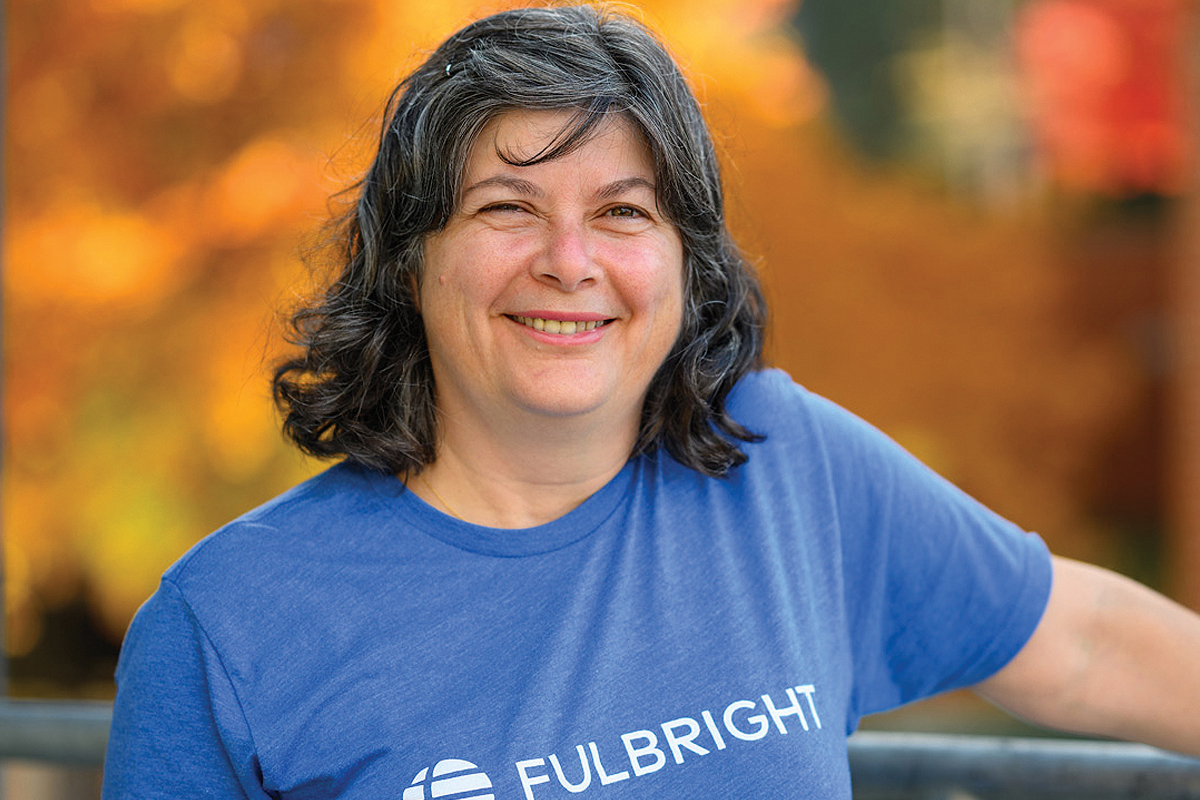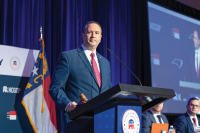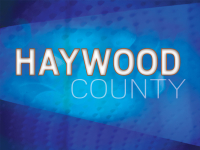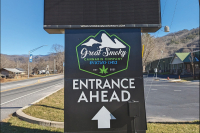WCU prof awarded prestigious Fullbright fellowship
 Western Carolina University associate professor Katerina Spasovska will soon head to Kosovo to teach and conduct research. WCU photo
Western Carolina University associate professor Katerina Spasovska will soon head to Kosovo to teach and conduct research. WCU photo
A Western Carolina University professor has been awarded one of the most respected fellowships in the world, which she hopes will not only shed some light on pertinent trends in media — both in the Balkans and in the United States — but also help to inspire her journalism students in the same ways she was, years ago.
“When I was an undergraduate student in a journalism program in Skopje [capital of the Republic of North Macedonia], there was a Fullbright scholar who came and taught reporting. She was a reporter for the San Francisco Chronicle, and she was just wonderful,” said Katerina Spasovska, associate professor of communications at WCU. “She kind of gave me a glimpse of what I could do.”
The Fullbright Program was established by a United States senator from Arkansas, J. William Fullbright, in 1946.
Fullbright, who would go on to chair the Senate Committee on Foreign Relations for 15 years during the early stages of the Cold War, wanted to promote a two-way cultural and intellectual exchange in hopes that it would also improve relations between the United States and countries throughout the world.
Administered by the U.S. Department of State’s Bureau of Educational and Cultural Affairs, the Fullbright Program awards nearly 8,000 scholarships and grants each year to artists, students, professionals and teachers like Spasovska.
During fiscal year 2020, total program funding was set at $439.7 million, the majority of which, more than $270 million, originated with the State Department. Foreign partner nations contributed nearly $100 million in direct and in-kind support. Private sector contributions from the U.S. added another $60 million, and the U. S. Department of Education chipped in $8 million.
Related Items
The program acknowledges Sen. Fullbright’s complex legacy — at the same time he championed greater understanding among people of diverse nations across the globe, he promoted segregationist ideals at home, including opposition to racial integration in public places and in educational settings.
However, the program’s results over the past 77 years speak for themselves. The 400,000-plus recipients of Fullbright scholarships in 165 nations include 41 heads of state, 62 Nobel Prize winners and 89 Pulitzer Prize winners.
The application process is extremely competitive.
In February, Spasovska will travel to the tiny Balkan nation of Kosovo for five months.
Home to nearly 2 million people, Kosovo is a landlocked country about half the size of New Jersey and is bordered by Albania and former Yugoslav territories including Macedonia, Serbia and Montenegro. The overwhelming majority of Kosovo’s population is ethnically Albanian, practices Islam and enjoys a relatively high quality of life similar to other countries in the region.
Kosovo was a nominally autonomous province of Yugoslavia from 1945 through the 1980s, but as Yugoslavia began to splinter following the fall of the Soviet Union, Kosovo declared its independence from Serbia, a majority Christian nation, in 1990.
Soon after, Serbian forces began to engage in brutal repression of the Kosovar independence movement, committing mass murder, war crimes and ethnic cleansing.
Called the Kosovo War, the conflict pitted Serbia and Montenegro — still calling themselves Yugoslavia — against the Kosovo Liberation Army. In 1999, NATO airstrikes brought an end to the fighting, but not before between 6,000 and 12,000 Kosovars ended up in more than 500 mass graves, according to a United Nations report from 1999.
Serbia still claims Kosovo as its own, however, 102 of 193 United Nations member states recognize Kosovo’s status as a sovereign nation. The U.S. formally recognized it in 2008.
Both Serbia and Kosovo now seek to join the European Union, however Serbia’s refusal to recognize Kosovo, along with Kosovo’s purported repression of ethnic Serbs in the northern part of the country nearest Serbia, has to end, according to EU President Ursula von der Leyen.
The U.S. helms a multinational military presence based in southeast Kosovo as tensions remain high between the two countries, although Spasovska says she feels Kosovo is safe — at least, right now.
“In our region, ‘tense’ can happen in 15 minutes and be de-escalated the next day, so it’s kind of a fluid situation,” Spasovska said.
A native of Macedonia, Spasovska worked as a reporter there and across the Balkans, just as Yugoslavia was falling apart.
She started out with freelance work, including broadcast television and radio, and went on to earn her master’s degree in 2000 from one of the top journalism schools in the world, the University of Missouri.
After a stint with the U.S. Agency for International Development’s media development program, she worked as an editor of an Albanian language political magazine started by her husband, who is also a journalist. In 2007, Spasovska began her doctoral studies at the University of Tennessee-Knoxville.
In Kosovo, Spasovska will serve as a member of a private university’s mass communications faculty, teaching two undergrad courses and one master’s-level course.
Spasovska will also conduct research into media development in southeastern Europe, in conjunction with working journalists there; it’s not a new topic for her.
“My dissertation topic was how journalists in Macedonia define professional journalism, and what I learned from that dissertation was that the pressures on younger reporters, especially reporters in broadcast media, are much bigger and heavier than among the older ones, the more established names,” Spasovska said. “But at the same time, the more established names were also connected with political elites. I want to see how in Macedonia it changed, has it changed in Albania, and let’s see what is happening over there in Kosovo.”
Another interesting facet of the media landscape in Kosovo is that since the Coronavirus Pandemic, print media has largely gone the way of the dinosaur in favor of digital outlets.
Kosovo also has a fairly young population, which may be a factor in digital news consumption. Per the CIA World Factbook , the median age there was 30.5 years in 2020, good for a rank of 120 out of 227 nations. Monaco, the oldest country in the world, has a median age of 55.4 years, compared to the United States, ranked at 61 with a median age of 38.5.
“They have a lot of young people, so In terms of how young people are using and accessing information, that’s a probably a string that will come up as a development,” Spasovska said. “But what does that mean for reporters? Because it’s very different how you reach audiences in traditional media, and how you reach them online.”
And that’s not the only parallel between journalism in southeastern Europe and in the United States. Some of Spasovska’s research could reveal important portents here.
“American media also have a problem that the media there have, which is dropping trust and credibility,” she said. “What I could contribute is, hey, here’s the reasons why and how that affects the media there.”
Another significant parallel is the concept of the “news desert.” Often rural, news deserts are places where there are no legitimate news sources. A 2022 study by Northwestern University’s Medill School of Journalism says that one-fifth of Americans live in a news desert, or in a community at risk of becoming one.
Around the same time as the Northwestern study, The Washington Post published a story claiming that each week, two newspapers in the United States close their doors and are not replaced. Multiple studies have suggested that when a community becomes a news desert, government transparency goes down, and the cost of governance — borne by taxpayers — goes up.
“At least in Macedonia — I don’t know if it’s true in in Kosovo — what happens a lot of the time is the desk will cover the world with translated information picked up from other media, like the Associated Press or Reuters. But the local stories are missing,” said Spasovska. “They will cover politics in Skopje as the capital, but the rest of the country is ignored. Nobody covers that. I’m from eastern Macedonia. There is not a good TV station or radio that covers the eastern region of Macedonia. And we’re talking about a country that is nearly 2 million people.”
While Spasovska’s work may add a little more shine to WCU’s academic reputation, she’s far from the first Catamount to be honored with a Fullbright.
Ingrid Bego, an associate professor of political science at WCU and native of Albania, currently serves as the director of the office of national and international student awards and is the Fullbright campus representative for students. Along with Wes Milner, director of global engagement, Bego hopes to boost WCU’s future Fullbrighters by bolstering institutional support for applicants, who can be current students, instructors or even alumni.

Ingrid Bego
Bego told The Smoky Mountain News that over the past few years, there have been about four student applicants each year, with some entering the semifinalist phase of the process.
Most recently, associate head of the department of physical therapy John Carzoli traveled to Bolivia to complete his Fullbright project. Turner Goins, a distinguished professor in the college of health and human services, embarked on a journey to New Zealand. Yanjun Yan, associate professor of engineering, traveled to Bulgaria.
“I think it’s important to devote more time and resources to strengthen WCU’s Fulbright footprint because of the mission of Fulbright to advance knowledge across communities and improve lives around the world,” Bego said. “I think it’s important that we bring the world to WCU, but I think it’s just as important to showcase what we have to offer here in Western North Carolina to the world. We have so much to give not only within the walls of the university but in our collaborations and work in the community. The Fulbright can make it all possible, building lasting connections between our people here in Western North Carolina and the people of other countries.”
Bego has plans to host a “Fullbright day” at WCU when applications open in April, to raise awareness of the program among students and faculty. For more information on the Fullbright program, visit us.fulbrightonline.org .













